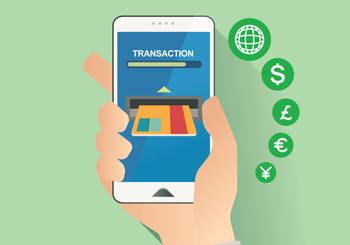In preparation for contributing an article to the year-end issue of connect, Kevin, along with four STS Committee members (Jordan Thaeler, Luis Artiz, Nick D’Alessio, and Uwe von Sehrwald), gathered for a roundtable discussion of 2017’s new developments, biggest surprises, and disappointments.
What was the most overhyped retail technology in 2017?
Jordan: It’s hard to remember what year the hype started, but I continue to see more bark than bite in both mobile payments and beacons. Mobile payments won’t take off until they eliminate interchange; and beacons are a spam program masquerading as something of utility. Nope and nope.
Kevin: Mobile payments are an overhyped solution trying to find a problem. Until a real pain point presents itself, consumers will remain happy pulling out their credit card to pay, without worrying about opening an app or a dead mobile phone. I thought that the delay in processing EMV cards would create an opening for mobile payments, but processors are actively reducing this time delay. Consumers do not want to be spammed with unwanted mobile offerings or have their locations tracked; and retailers do not want to pay higher fees or for incentives to drive mobile usage. So, it looks like mobile payments will have a long and slow adoption curve.
Nick: BLE Beacons for mobile push solutions, such as marketing and couponing.
What technology are you happy that you adopted in 2017?
Luis: In our business, we are seeing adoption of our cornerstone printer, which allows the retailer to connect to 3 different terminals simultaneously wireless or wired), and enables retailers to change their operations workflows and store designs, without having to purchase all new infrastructure.
Mario: EMV and P2PE. Assisting customers in the implantation of chip-based cards (EMV) was very beneficial towards the continued usage of tablet-based functionalities. Along with EMV, Point to Point Encryption (P2PE) and End to End Encryption (E2EE) added to the security of data, while reducing PCI scope requirements. These two technologies were in high demand as customers enhanced their payments ecosystems.
Uwe: Ecommerce for sure. This is (or needs to be) strategic for all retailers, especially with Amazon and Walmart, and now the Amazon-Whole Foods merger. You simply need to prepare your store to handle ecommerce, and take advantage of your brick-and-mortar experience with the added benefit of using ecommerce.
What surprised you in the retail technology market in 2017?
Jordan: The rapid adoption of cloud POS and the phasing out of the dealer channel . . . which go hand in hand, I suppose. If you’re a dealer, you had better learn to offer real value. If you’re a legacy POS company—and haven’t invested the trivial $20K in data replication for an API layer—good riddance. The market works and you will not win that fight.
Mario: The utilization of tablets to enhance customer engagement and operational efficiency. Across the retail spectrum the use of tablets to execute various job functions was surprising. Along with that, the lack of software and network infrastructure are still big hurdles that stand in the way of many organizations looking for hardware/software improvements.
Nick: The adoption rate of Click & Collect solutions for online ordering, pick up in-store—everyone seems to be implementing some form of this, especially grocery.
Uwe: Amazon and Whole Foods. Secondly, the lack of fully integrated solutions to ecommerce.
How do you see the retail customer experience changing in 2018?
Jordan: More data will be collected and made available for better customer interactions. It’s trite, but right place, right time, right price will be closer to reality with 1-to-1 customer optimization courtesy of machine learning.

Luis: Consumers are going to continually change, and retailers have to keep up. We are going to continue seeing a shift to helping consumers get the “boring things” done easily, so they can go do the things that they really want to be doing.
Less checkout lines, more in-store “try before you buy” experiences. Retail stores will let you buy clothes AS you walk out of the fitting room. No lines.
Increase in home food delivery capabilities. Take, for instance, the preparation for a football BBQ at home: The night before, you’ll be able to order all your food, spices, appetizers, drinks, AND beer from a few apps; then everything arrives in the morning for you to start your party.
Retail store as the “service” center . . . for example: The company REI uses their brick and mortar as your hub for your purchases. You can try on and buy clothing in-store. However, if you don’t want to stand in line (especially on sale days), you can scan and order your merchandise to be delivered to your home. And if you need to return it, you can either mail it back or return/exchange at the store. All their systems are linked, so that the experience is unified.
Easier transactions at experience “locations.” As consumers move to spending a higher percentage of their available resources on experiences (like music festivals, concerts, outdoor treks, sporting events, beach resorts, spas), merchants will have to figure out a way to make the consumer’s entire process amazing. We’ll see things like bank cards connected to music festival wristbands for easier (and frequent) purchasing, more pool-side ordering technology to get food and drinks delivered quicker (and more often), and more in-seat ordering at stadiums (so you don’t miss a play after spending $100+ on game tickets).
Nick: I see the migration to more mobile-enabled commerce across the retailer’s store/ecom properties continuing to expand. More mobile payment adoption coupled with in-aisle transactions.
Which technologies are you keeping your eyes on for 2018?
Jordan: Prescriptive analytics. Prescriptive analytics are the layover to automation, which I expect to hit retail in 3 to 5 years—as soon as merchants realize how low their margins are, how time-starved they find themselves, and how poorly they make decisions even given quality data.
Kevin: Technologies that make it easier for retailers to operate their business. Small retailers have so much to do every day, and increasingly they value technology that simplifies their work. One example is voice recognition. The rapid adoption of voice assistants— Amazon’s Alexa, Google Home, Apple’s Siri, Microsoft’s Cortana—will create all sorts of ways to streamline product search and ordering using voice commands for both retailers and customers.
Mario: Data analytics and Core PC technologies. Customers are looking for ways to maximize business operations by attaining enhanced data. With various technology-driven input points, information can be used to assist in many facets of a business. Core PCs (wearables) is another technology that organizations are starting to ask about, in determining if employee efficiencies can be had with this emerging technology.
Nick: Augmented reality—as more stores begin to push mobile applications, and the capabilities and unlimited data plans continue to gain ground, retailers will be able to drive a richer shopping experience to customers who opt-in.
The STS committee works to identify emerging technologies that may be of benefit/interest to RSPA members and/or their customers. The committee also provides an article published in each issue of connect magazine.
Download a PDF:
![]()
 Luis Artiz
Luis Artiz Mario Carrillo
Mario Carrillo Nick D’Alessio
Nick D’Alessio Kevin Kogler
Kevin Kogler Uwe Von Sehrwald
Uwe Von Sehrwald Jordan Thaeler
Jordan Thaeler


